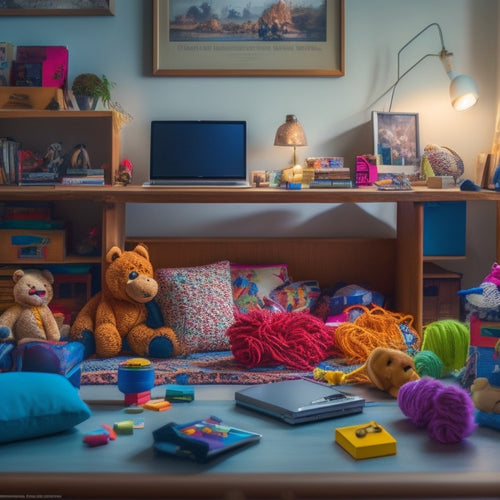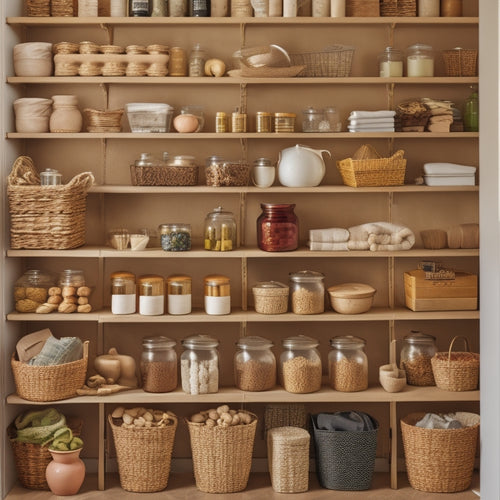
NURSERY CLOSET INSPO: Creative Storage Solutions
Share
A nursery closet that's both functional and stylish can be achieved with creative storage solutions. Maximizing closet space is key, so assess the layout and strategically place shelves, bins, and storage boxes. Categorize clothes into bins by type for a streamlined system, and incorporate cube organizers and storage totes for space-saving. For a dresser, use dividers to separate clothing categories and assign specific drawers for different types. Then, add a touch of style with cute storage bins in various shapes, sizes, and colors that match the nursery theme, and get ready to discover even more innovative ideas to create a serene and organized space.
Key Takeaways
• Incorporate DIY shelving solutions for vertical storage to maximize nursery closet space.
• Use cute storage bins in various shapes, sizes, and colors to match the nursery theme for style.
• Categorize baby clothes by type and utilize cube organizers for easy organization and visibility.
• Implement a 'one in, one out' policy to maintain a balanced inventory of baby clothes and accessories.
• Label each storage bin and shelf to ensure easy identification and access to what you need.
Maximizing Closet Space
When it comes to maximizing closet space in a nursery, an important first step is to assess the layout and identify areas where shelves, bins, and storage boxes can be strategically placed to create a functional and organized system.
A well-designed closet layout is essential for making the most of the available space. Consider installing shelves for additional storage and utilizing bins for easy organization. Categorize clothes in bins by type, such as onesies, pajamas, and pants, to create a streamlined system.
Don't forget to incorporate space-saving hacks, like cube organizers and storage totes, to maximize every inch of your nursery closet. By optimizing your closet layout, you'll be able to store more and stress less.
Dresser Organization Essentials
With a well-organized closet in place, turn your attention to the dresser, where a thoughtful layout can make a significant difference in the overall functionality of the nursery. A well-planned dresser organization system can streamline daily routines and make the most of the available space.
To achieve this, consider the following essentials:
- Drawer dividers to separate clothing categories
- Assigning a specific drawer for each type of clothing (e.g., onesies, sleepers, pants)
- Implementing a 'one in, one out' policy to maintain a balanced inventory
- Using stackable drawers or baskets to maximize vertical space
- Labeling each drawer to ensure easy identification
Creative Storage Ideas
Incorporating creative storage ideas into your nursery closet and dresser can make a significant impact on the overall functionality and aesthetic of the space. Consider DIY shelving solutions to maximize vertical storage and create a visually appealing display.
Cute storage bins in various shapes, sizes, and colors can add a pop of personality to your nursery while keeping essentials organized. Take inspiration from your nursery theme to choose bins and storage solutions that match your style.
Organizational tips, such as categorizing clothes by type and using cube organizers, can help maintain a clutter-free space. By incorporating these creative storage ideas, you'll create a functional and stylish nursery that's both efficient and adorable.
Frequently Asked Questions
How Often Should I Wash and Replace Baby Clothes?
"Wash baby clothes after every 2-3 wearings, or immediately after soiling. Prioritize stain removal and fabric softness to maintain cleanliness and comfort. Regular washing prevents buildup and keeps clothes fresh for your little one."
What's the Ideal Closet Temperature for Storing Baby Clothes?
Maintaining an ideal closet temperature between 60-70°F (15-21°C) and controlling humidity levels below 60% guarantees the best conditions for storing baby clothes, preventing moisture buildup and fabric damage.
Can I Use Vacuum-Sealed Bags for Storing Out-Of-Season Clothes?
When storing out-of-season baby clothes, vacuum-sealed bags can be a space-saving solution, but beware: they can also trap moisture, potentially damaging fabrics. Instead, opt for breathable, fabric-protecting storage options that preserve clothing quality.
How Do I Prevent Mildew and Moisture in the Nursery Closet?
To prevent mildew and moisture in the nursery closet, maintain a 1-inch gap between stored items and utilize shelf liners to absorb excess moisture, keeping the space dry and fresh.
Should I Organize Clothes by Season or by Age Range?
"Organizing by season or age range? Consider your personal style: categorize by season for a more fluid approach or by age range for a more structured system. Color coding can enhance either method, ensuring a visually pleasing and functional nursery closet."
Conclusion
In the nursery closet, chaos is a thief of tranquility, stealing moments of peace and replacing them with anxiety. However, by implementing creative storage solutions, the closet can be transformed into a sanctuary of serenity.
Like a gentle breeze on a summer day, organized shelves and categorized clothes soothe the mind and calm the spirit.
By embracing the wisdom of maximizing closet space, dresser organization essentials, and creative storage ideas, the nursery closet can become a haven of harmony, where love and care flourish.
Related Posts
-

Why Cluttered Homes Need Professional Online Guidance
You're likely no stranger to the feeling of being overwhelmed by clutter, and it's precisely this sense of paralysis ...
-

10 DIY Pantry Shelf Hacks for More Space
You can change your pantry into a highly functional and organized space with these 10 DIY shelf hacks that maximize s...

